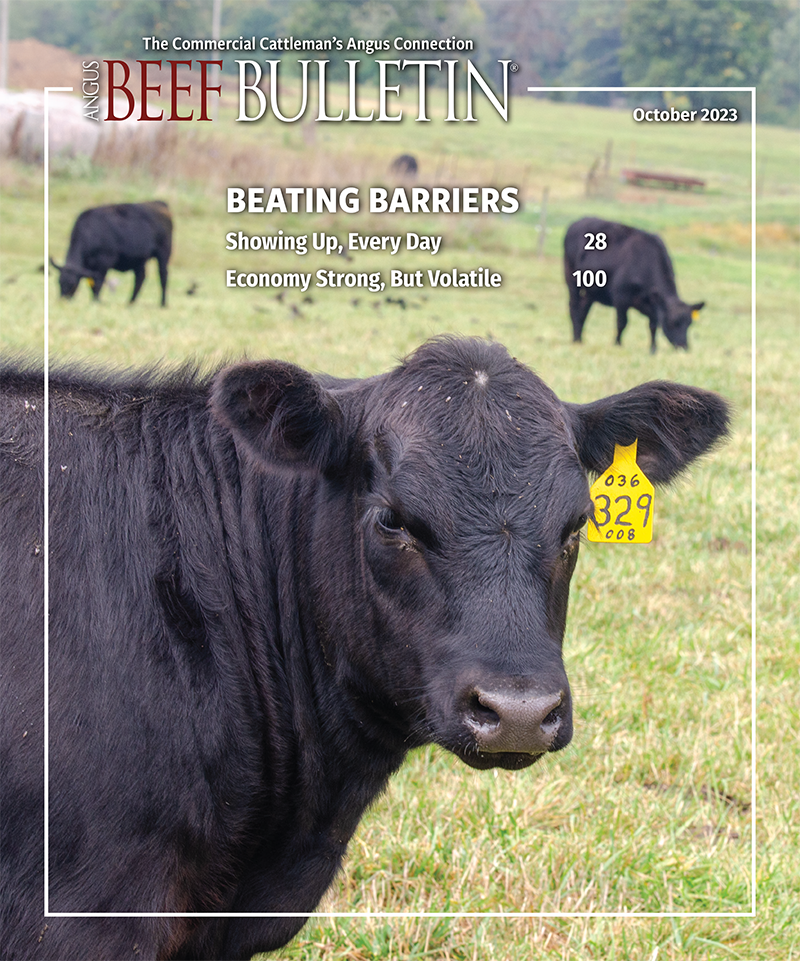
Backgrounding Calves
Managing a backgrounding operation is an easier way to get started in the cattle business.
Backgrounding means growing weaned calves to a heavier weight before they go into a finishing program. Some producers buy light calves to put on grass and grow to a larger size. Some buy weaned calves to put into a confinement program and feed a growing ration until they are ready to go to a finishing facility.
Eric Bailey, University of Missouri Extension beef specialist, says that in the stocker/backgrounding business, money is made on how you buy calves.
“The average backgrounder takes a 400-500-pound (lb.) calf to 700-800 pounds and resells it,” he says.
To be successful, you need accessible and affordable feed sources. In Missouri, there are opportunities to buy small groups of calves because there are many small-scale cow-calf producers. Lot size affects sale price. Also, there are opportunities to upgrade calves from small-scale farms. A person can pick up calves here and there, shape them up and eventually make uniform bunches to resell at a heavier weight.
“Our goal is to enhance stocker cattle systems in Missouri by utilizing an intensive early stocking system in the Fescue Belt — looking at timing of grazing and shorter duration,” he explains.
“Many people think in terms of a backgrounder/stocker system as 150- to 180-day grazing program. But by running twice as many animals for half the time, you harvest the forage when it is highest quality — early in the season. You don’t subject those cattle to summer slump.”
The cattle are not affected by late-summer heat and the effects of fescue, which reduce their heat tolerance and negatively affect gain.
Fescue has two growth peaks throughout the year. The first peak is from early April into June. A secondary peak of growth happens in September-October. Good fescue will produce 4 tons of forage per acre. About two-thirds of that tonnage comes from spring growth and one-third comes in the fall, explains Bailey.
“I am a huge proponent of management-intensive grazing (MiG) because it’s a great tool; but, I know the effort it takes,” Bailey says. “It’s not for everyone, and many places are not set up to do it efficiently. I try to create simple systems that can work for more cattle producers.”
He says the surface has only been scratched when it comes to opportunities for more backgrounding in Missouri as a way to add value to calf crops. Missouri produces nearly 2 million calves each year, but 85% of them leave the state at weaning. There is tremendous opportunity to do more backgrounding.
“We lack the large feedlots and slaughter capacity,” he says. “In the future, I believe our best asset is an 800-pound steer that is ready to go on feed somewhere, rather than a 500-pound steer that somebody else has to straighten out and then grow and then put on feed.”
Anyone can background calves without a huge investment in land and facilities, says Bailey. In his own small venture a few years ago, he drained his savings account to buy nine heifer calves. They were a good buy, and he made $175 per head on them. Instead of buying 100 head of cows, waiting nine months for them to calve and another nine months for those calves to grow, he made a 15% return on his investment in 90 days.
There is always some risk when buying, growing and reselling cattle. It’s market-driven, and you also have to deal with whatever you get bought, Bailey cautions.
“We had one heifer that was wild; her flight zone was about one-eighth of a mile,” he recalls. “If people buy cattle to background, fences need to be good, and they need to be prepared for extremes.” This is different than a cow-calf operation in which a person can select for desired traits and cull the animals that don’t fit or are hard to manage.
While Bailey admits the cow-calf business is a great life, he says it is hard to make a living in it. The stocker cattle business requires a much lower capital investment and is easier to get into. You can lease land and graze stockers — taking someone else’s cattle to put on gain and charge between 50¢ and 60¢ per lb. of gain. You are marketing your skills and husbandry and don’t have to get a $250,000 loan to buy land and cows.
Bailey says he is passionate about this segment of the industry because it gives more people opportunity to be in the cattle business.
“As older producers retire, a person might be able to lease their land. I am dismayed by the lack of young people coming back to the farm, but it’s hard to make a cattle business pencil in a way that would allow someone to borrow money to buy a ranch,” he says. It’s easier to get started by leasing land and running stocker cattle.



